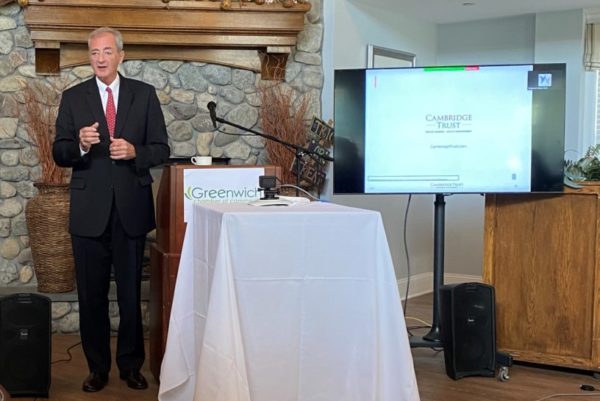The state of the economy: A work in agitated progress
The Greenwich Chamber of Commerce hosted its 2022 Annual Meeting & Business Forecast at the Greenwich Water Club earlier this month, with John Traynor, president of Cambridge Trust Wealth Management of Connecticut, as the keynote speaker.
Traynor”™s presentation, titled “Taking Away the Punch Bowl,” detailed his observations on the economy both from a national and state level and how the Federal Reserve”™s plan to raise interest rates is meant to address the economy”™s underlying issues.
“The economy”™s actually in fairly good shape. The warning area that”™s crazy right now is the employment side,” Traynor said.
Traynor demonstrated the problem by contrasting participation rates in the labor force between the 1960s and today. In the former time period, 97% of men between the prime working ages of 24 and 55 participated in the labor force, as opposed to 88% today. Labor force participation rates are of concern to both the Federal Reserve and employers ”” since the early 2000s, participation rates have trended downward while the size of the labor force continues to grow, being further exacerbated in early 2020 by the pandemic.

Traynor said Covid-19 greatly disrupted consumer spending as well, with expenditures on goods and services plummeting with its arrival, services suffering the most. Since then, both have recovered. Expenditure on goods in particular have done very well, with real demand since 2021 being around $400 billion above even the pre-pandemic trend. Expenditures on services have been slower to recover, however, still being approximately $400 billion below the pre-pandemic trend.
The trajectory of inflation, partly a result of supply chain issues and made worse by the Ukraine war pushing commodity prices up, was illustrated by Consumer Price Index (CPI) levels through the years. In July 2022, the Headline CPI was at 8.5%, the Core CPI at 5.9%, the Food CPI at 10.9% and Energy CPI at 32.9%. The Headline CPI for July was an improvement from June 2022, which was at 9.0%, but was still significantly higher than previous years such as 2018, which had a Headline CPI of just below 3%.
“For inflation, if you take out energy and food, it”™s still 6.3%, so the Fed has a long way to go,” Traynor said. “Their goal is 2%, so that”™s why they said they”™re going to raise rates, and then they”™re going to keep them there for a while. They really want to get that inflation out of them.”
Traynor stated the Federal Reserve seeks to address these and other economic problem areas and avoid a looming recession by slowing down the economy by raising interest rates.
“When the party gets going, when the economy gets moving along very nicely, it”™s the Fed”™s job to take that punch bowl away, to basically dampen things down,” Traynor said.
By raising interest rates or “taking the punch bowl away,” unemployment rates are likely to go up, according to Traynor. However, the Federal Reserve”™s hope is that instead of this resulting in layoffs, employers will elect to shrink job openings.
“What the Fed is hoping is that the unemployment rate doesn”™t go up and that would be perfect,” Traynor said. However, “it has never happened before ”” I”™d love to see it happen ”” but that”™s exactly what the Fed is hoping.”
Regarding the economy of Connecticut, Traynor detailed the importance of international trade and globalization to the state, pointing out that 20% of Connecticut jobs have some ties to international trade.
“These jobs grew 5.6 times faster than overall jobs between 1992 and 2016,” he added.”
Furthermore, Traynor pointed out that most of Connecticut”™s exports are highly engineered machine tools, such as biotech equipment and turbofan blades, which Traynor described as being highly valued around the world. As such, he cautioned against a growing trend toward deglobalization in the state, arguing that any move away from global free trade would only hurt Connecticut”™s economy.